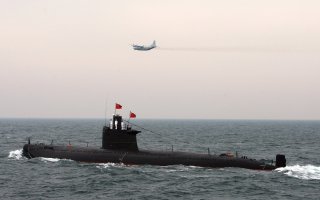How the U.S. Navy Plans To Fight China's Submarines
The Navy has a wide variety of modern weapons to find and destroy enemy submarines.
Here's What You Need to Know: Anti-submarine warfare is an art learned in two world wars.
With things heating up in the South China Sea (SCS), much attention has been paid to the ships and submarines that could potentially square off against each other in the region. This ignores a key asset of most navies that is already on the “front lines” and shaping military interactions—Maritime Patrol Aircraft (MPA). Skillful use of these aircraft may determine how an engagement plays out, or it could prevent one from happening in the first place.
MPA have been around almost as long as combat aircraft. Navies quickly realized the potential of aircraft when it came to patrolling the sea, as they could move far more quickly than boats and had the significant advantage of altitude.
But modern MPA use advanced sensors to detect to see far more than what can be seen with the naked eye—Magnetic Anomaly Detectors (MADs) can detect underwater submarines, and radar systems are used to detect ships that might just be specks on the horizon. Infrared/thermographic cameras allow MPA to identify vessels even at night.
MPA can also deploy sonobuoys, floating sensors that either detect noises or send out pings to find submarines. ELINT sensors can detect the radar emissions of enemy MPA or ships. All of these sensors means that MPA are incredibly useful in peacetime as well as wartime.
One way they could deter potential escalation is through detecting potential violations of EEZ or civilian ships in contested waters ahead of time through the use of radar and infrared. Since modern MPA have all-weather detection capability, they can watch for fishing vessels day and night, and give a navy an advanced warning of such violations so they can be headed off before a more violent encounter up close.
MPA also can provide critical information in tracking enemy submarine posture. While this is a more intensive and not “guaranteed” way to track submarines—as the battle between submarine stealth and submarine detection is ongoing—determining the patrol routes and positions of enemy submarines is critical information. Such intelligence may allow nations to avoid potential losses to convoy raiding (if it occurs) and set up anti-submarine warfare plans before the event of war.
In their traditional role in the detection of surface ships, MPA are critically important in the SCS region. Due to the relatively short distances between islands, MPA flying out of Japan or Taiwan could potentially track the movement of ships from base to base in China.
Basic MPA surveillance radars like the Seaspray 5000 have publicized ranges of around 200 nm. The more advanced AN/APS-115 and AN/APS-137D(V)5s mounted on Japan, and Taiwan's P-3C MPA undoubtedly have better performance. Even with a 200 nm range, an MPA flying over the East China Sea could easily track ships moving south along China's coast.
This could yield significant strategic intelligence on the development and deployment of Beijing’s People’s Liberation Army Navy (PLAN). In addition, the ELINT suite onboard these aircraft could provide insight into the capabilities of Chinese radars.
However, MPA still face considerable limitations from the human component. Crews get tired and need to be rotated out, and MPA—like other aircraft—are expensive to fly and operate. Therefore, the future will see navies using UAVs to accomplish the MPA mission, assisting manned MPA and also surveying without them independently.
The U.S. Navy has already made significant steps in this direction with the acquisition of MQ-4C Triton UAVs, which can augment the P-8A in surveillance and patrols. As multiple UAVs can accompany a single manned aircraft, the amount of area patrolled can increase drastically with the integration of UAS, bringing even more benefits.
Most militaries in the region appear to have recognized the importance of MPA in securing their maritime borders. While not in the SCS, Japan's Defense Forces have one of the best MPA fleets, the star of which is their purpose-built Kawasaki P-1, which boasts advanced sensors and even artificial intelligence to reduce the crew workload.
Taiwan is also no slouch, acquiring twelve American P-3C Orions MPA in 2017. Other militaries in the region (such as Vietnam, Singapore, and the Philippines) field lighter MPA, mostly converted civilian light propeller planes as opposed to heavier purpose-built aircraft. While these converted aircraft are sufficient for tracking surface ships, purpose-built aircraft are far superior for tracking submarines, due to features like the extended tail on the P-3C, which houses the magnetic anomaly detector.
China's premier MPA is the Y-8Q, which is a rough analog to the P-3C in function. Like the P-3C it has a distinctive tail boom for detecting submarines, and a powerful surface search radar in a radome under the cockpit.
Charlie Gao studied political and computer science at Grinnell College and is a frequent commentator on defense and national-security issues.
This article first appeared in August 2018.
Image: Reuters

